Basic knowledge in the production of daily ceramics
1. Ceramic classification
1. Stoneware
Firing temperature: The firing temperature is between 1200-1250 degrees. Generally, two firings are used, first low-temperature biscuit firing and then glaze firing.
Features:
The green body can be made thinner and lighter.
Stoneware has high viscosity and density, and its water absorption rate is about 7%.
The glaze is suitable for producing glazes of various colors.
Good strength and wear resistance.
Usage precautions and scope of application:
Suitable for microwave oven, dishwasher and oven.
It is recommended not to use knives and forks for glazed matte ones.
2. Porcelain
Firing temperature: The firing temperature of high-temperature porcelain is about 1250-1300 degrees, and it is glazed and fired at one time.
Features:
The product has good hardness and strength and is not easily broken.
Porcelain clay has high viscosity and density, and its water absorption rate is about 0.2-0.5%.
It has good thermal stability, is resistant to rapid cooling and heating, and will not crack the glaze.
The product has good whiteness and fine porcelain quality.
The glaze water of high-temperature porcelain is relatively limited, and it cannot be used to produce rich-colored glazes like medium-temperature ones. Light and bright colors are prone to color aberration and glaze flow.
The product has been completely porcelain after being fired at high temperature, but it is prone to small black spots (iron) and deformation.
It has low lead and cadmium leaching rate, acid and alkali resistance, no lead poison, and easy to wash.
Usage precautions and scope of application:
Suitable for dishwashers, microwaves, and ovens.
3. Dolomite
Firing temperature: The firing temperature is about 900-950C. After one bisque firing, glaze firing is performed.
Features:
Lightweight porcelain has a lighter texture and poor light transmittance. The body is usually thicker and feels bulkier.
Porcelain clay has poor viscosity and density, and its water absorption rate is 20-25%.
Lightweight porcelain has poor strength and is prone to damage and cracking of the glaze.
It is easy to produce bright colors and is suitable for processing painted pictures and bright colored glazes.
It has good plasticity and is not easily deformed when fired.
The temperature resistance is not enough, and rough edges and deformation are likely to occur when the glaze is overheated during firing.
Poor strength and not wear-resistant.
Usage precautions and scope of application:
1. Pay attention to product collision.
2. Suitable for microwave ovens, not recommended for dishwashing, and not suitable for ovens.
4. Earthenware
Firing temperature: The firing temperature of heavy porcelain is 1050 degrees. After one bisque firing, glaze firing is performed.
Features:
The texture of heavy porcelain is heavier than that of earthenware, and its light transmittance is poor. The body is usually thicker and feels bulkier.
Heavy porcelain clay has poor viscosity and density, and its water absorption rate is 18-20%.
Heavy porcelain is less likely to be broken than light porcelain, but its strength is also worse than medium-temperature stoneware.
It is easy to produce bright colors and is suitable for processing painted pictures and bright colored glazes.
It has good plasticity and is not easily deformed when fired.
The glaze is finer, but not strong enough and easily scratched.
Usage precautions and scope of application:
1. Pay attention to defects;
2. Suitable for microwave ovens and dishwashers, but not for ovens.
5. Magnesia porcelain
Firing temperature: Firing temperature is between 1300-1350 degrees, fired at one time.
Features:
It has outstanding characteristics such as high whiteness, high strength, and high thermal stability.
Magnesia porcelain is mainly made from soil that contains high levels of magnesium, aluminum and other elements. Magnesia porcelain comes in two colors: beige and white magnesia porcelain and ivory white magnesia porcelain.
Porcelain is delicate and milky white, thin and translucent, has a fat sheen, and feels smooth to the touch.
It has low lead and cadmium dissolution rate, acid and alkali resistance, no lead poison, and easy to clean.
It has good hardness and wear resistance, can withstand collisions and is not easily damaged.
Precautions for use and scope of application:
Suitable for microwave, dishwasher and oven.
6.Bone china
Firing temperature: The firing temperature is between 1250-1300 degrees, and it needs to be fired twice.
Features:
It uses animal bone charcoal, clay, feldspar and quartz as the basic raw materials, and is made by high-temperature biscuit firing and glaze firing twice.
The grades of bone china are distinguished by the content of animal bone char. The national standard bone char content is above 36%.
The body is thin and bright, the porcelain is delicate, the color is milky white, and the glaze is uniform, bright and smooth.
Hold the porcelain in the palm of your hand and tap the edge of the porcelain with your hand. The sound will be crisp and lingering.
Since the raw materials contain a large amount of bone powder, which makes the porcelain clay less viscous, extra care must be taken during production and shaping.
The shrinkage rate of bone china is very large during the firing process, so the shape is easily deformed. (The shrinkage rate of bone china can reach 20%)
During the firing process, high requirements are placed on the regularity, whiteness, transparency, thermal stability and other indicators of the product, so the defective rate is also relatively high.
It has low lead and cadmium leaching rate, acid and alkali resistance, no lead poison, and easy to wash.
Precautions for use and scope of application:
Do not excessively exchange heat and cold during use to prevent explosion.
Please do not burn it directly in an open flame.
Microwave and dishwasher safe.
7. New bone china
Firing temperature: The firing temperature is between 1250-1280 degrees, one firing.
Features:
It was originally an ordinary high-white porcelain, but the content of calcium oxide in the composition is slightly higher than that of ordinary porcelain, and it has a little light transmittance. New bone china is not a new variety of bone china, but just borrowed its name.
The bone char content in porcelain clay is very low or there is no added bone char ingredient.
Imitation bone china is thicker, slightly yellower in color, and heavier than real bone china.
The porcelain is fine in texture and milky white in color. The product density is good and the water absorption rate is below 0.2%.
It has low lead and cadmium leaching rate, acid and alkali resistance, no lead poison, and easy to wash.
The product has good density, strength and wear resistance, and the water absorption rate is below 0.2%.
Precautions for use and scope of application:
Microwave and dishwasher safe.
2. Ceramic molding types
1. Grout injection molding operation
Grout injection molding is to inject prepared mud into a plaster mold. After the water in a layer of mud close to the mold wall is absorbed by it, a uniform mud layer of appropriate thickness is formed. After the remaining slurry is poured out, the mud blank will be dehydrated due to dehydration. Shrinks and separates from the model to form a blank.
Grout injection molding products generally include round relief bowls and cups, irregular-shaped teapots, vases, essence stoves, sake bottles, etc.
The mud inside the grouting must be poured out in 5-10 minutes after grouting, and the product will be removed from the mold in 40-60 minutes. After the green body is demoulded, use a fan to dry it. After the green body is dried for about 3-4 hours, water can be applied to repair the green body. Plaster impressions can be produced approximately 7-8 times a day. It takes about 80 times for grouting mold printing to produce mud blanks, and about 60-70 times for relief product mold printing to produce blanks.
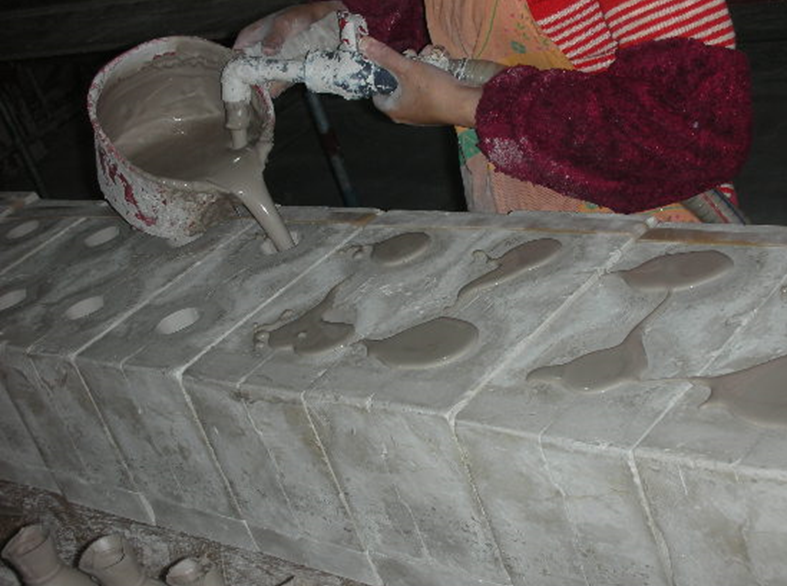
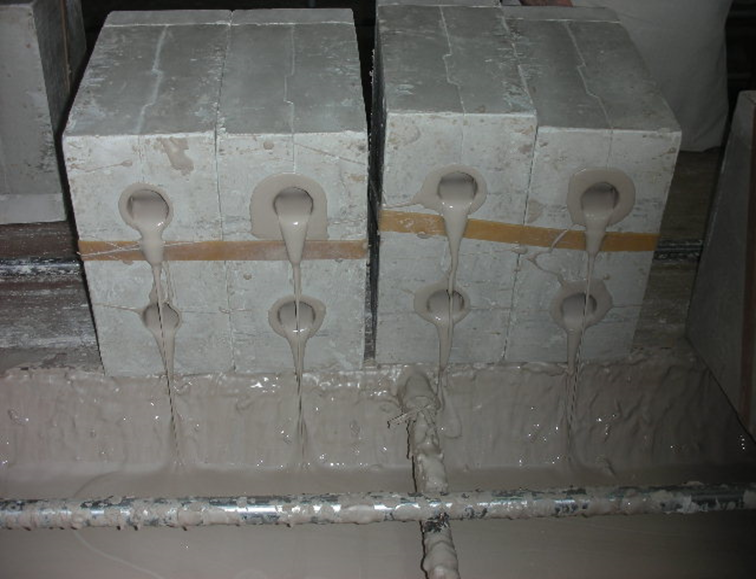
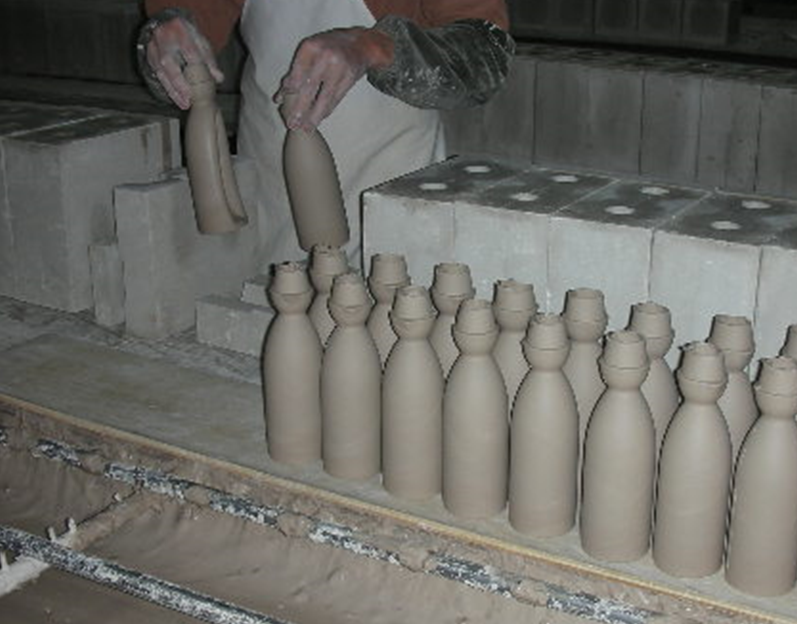
2. Pressure forming operation
Ceramic pressure molding uses a vacuum grouting machine to press mud into the mold. The mud is continuously absorbed by the mold to form a green mud. Pressure molded products are generally plate-shaped, as well as irregular-shaped products such as square bowls, special-shaped bowls, etc. The time for product removal is generally 30-40 minutes. Mold printing can be produced approximately 10 times a day. Pressure product molds are flat and can produce clay blanks about 80 times. For example, if the product molds have a relatively thick relief pattern, plaster molding can produce clay blanks about 60 times. If the molding surface is relatively fine, plaster molding production can Clay blank about 40 times.
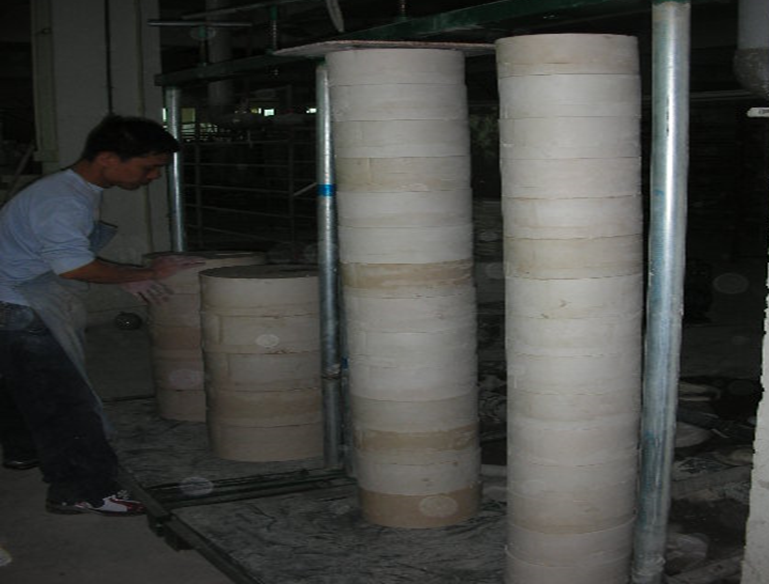
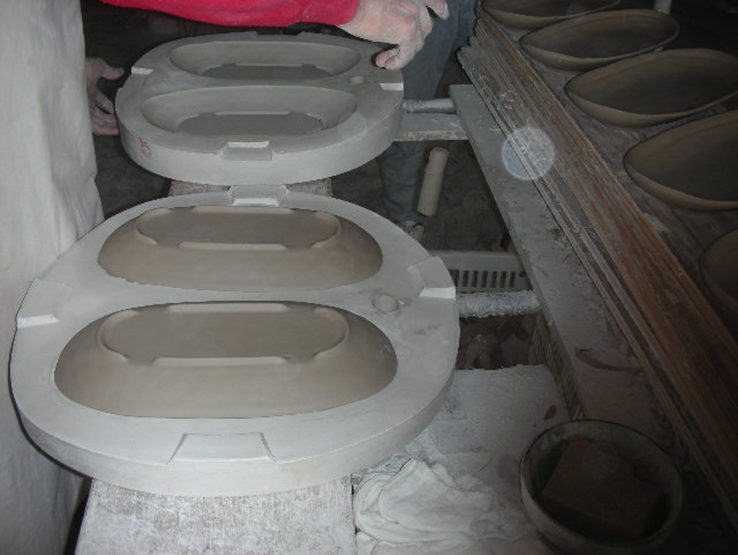
3. Roll forming operation
In roll forming, the model holding the mud material and the rolling head rotate around their own axes in the same direction at a certain speed. The rolling head gradually approaches the model holding the mud while rotating, and "rolls" and "presses" the mud to form the green body. Roll-formed products are generally round in shape: such as discs, bowls, cups, etc. The demoulding time of the product bowl is about 40-50 minutes, the demoulding time of the disc is about 30 minutes, and the demoulding time of the cup is about 50-60 minutes. Depending on the product type, the demoulding time will be different, and the pallets and shaping boards used will also be different. For products such as plate-shaped utensils, one machine can mold around 1,500 pieces per day, and for round bowls/cups, the number per day is around 2,000. It takes about 80 times to roll and stamp the blank.
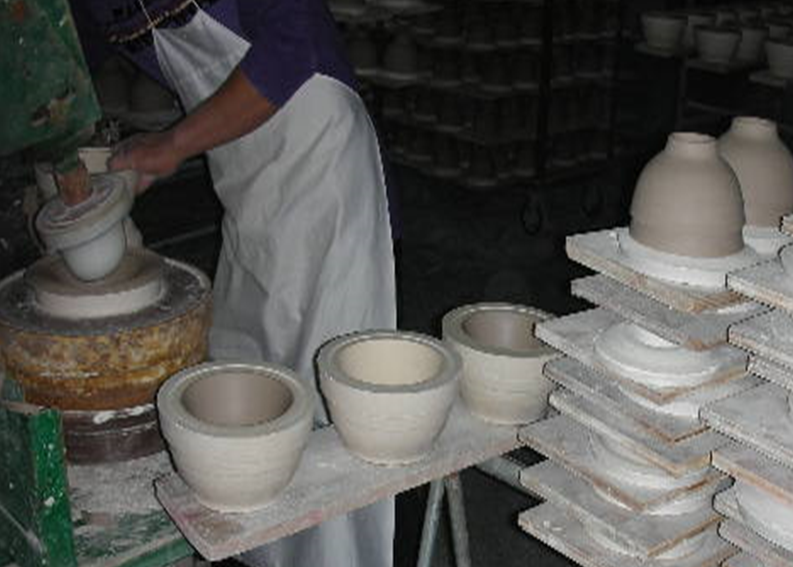
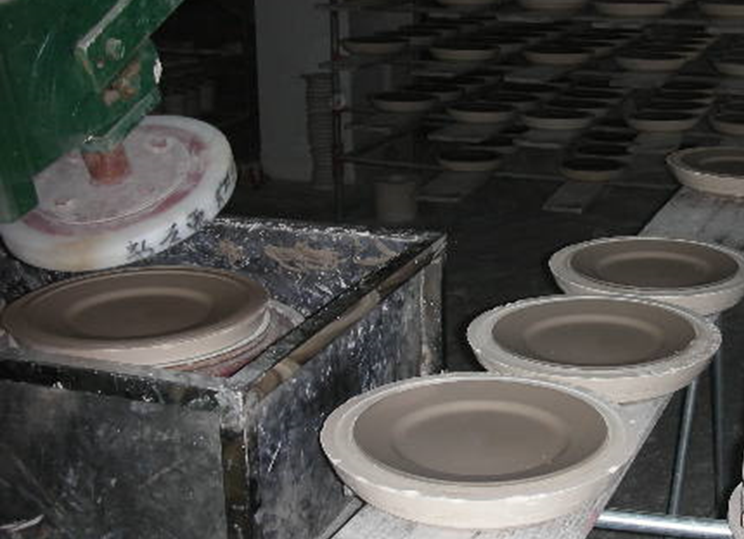
3. Types of glaze
1. Ordinary medium temperature glaze (glossy, matte, semi-matte)
2. Crack glaze (explanation attached)
Firing temperature: The firing temperature of medium-temperature crack glaze is around 1150-1200 degrees, and it is glazed and fired at one time.
Features:
Since the expansion coefficient of the glaze is greater than that of the blank, during the glaze firing process, the glaze surface generates greater tensile stress, causing the glaze surface to be covered with many small cracks, some sparse and dense, some long and short, some curved and some straight. Cracks, and will continue to crack after leaving the kiln.
The cracks on the glaze cannot be felt with your hands, but they are not sealed. Cracks can only be felt when the glaze layer is thick and has large cracks.
Due to the viscosity, density and glaze characteristics of porcelain clay, the water absorption rate of this product is about 10%.
The product will seep slightly, so it is recommended not to cause internal or external cracks.
The stability of glaze water is not enough and the operability of workers is high. The main reason is that the glaze water and fluidity are better, and the operation requirements are higher, so problems such as glaze accumulation and color difference are prone to occur.
Usage precautions and scope of application:
Due to the characteristics of glaze, the glaze surface is easy to bleed. It is recommended to try not to hold dark-colored soups and foods that are easy to precipitate and evaporate.
Dishwasher suitable, microwave and oven not suitable.
3.reactive glaze
Firing temperature: The firing temperature of medium temperature kiln glaze is about 1250 degrees. Generally, it is fired twice, first with low temperature, then with high temperature and then with glaze firing. Most kiln-varnished glazes are glazed in one go, but some colors require two glazes.
Features:
The color of kiln glaze mainly depends on the combination of porcelain clay and glaze water and the control of firing temperature.
Kiln variable glaze is sensitive to the control requirements of firing temperature, and the color effects of products fired at different locations in the same kiln will be different.
The product effect of kiln-turned glaze is difficult to achieve consistency, and there will be certain differences between individuals, but it can be controlled within a certain range.
The glaze water in the kiln has a certain volatility, so if the temperature is too high or too low during the firing process, different color effects and yields will occur. If the temperature is too high, the glaze will produce bubbles and blacken, and if the temperature is too low, the glaze will turn yellow and fog.
Because the glaze water has a certain volatility, such products cannot use glaze-fired bottom labels. If the base mark is glaze fired, the base mark will be scattered during the firing process, resulting in the base mark coming out incomplete.
There will be obvious differences between the products produced after glaze repair and back-firing and the products fired once. Moreover, the yield rate of the second re-firing will be lower. Some kiln-transformed glazes cannot be re-fired.
The product has good strength and wear resistance.
Precautions for use and scope of application:
Suitable for microwave oven and dishwasher.
4.Transparent glaze
5.Flower glaze
6.Pearl glaze
4. Types of process effects
1.relief
2. Yin carving
3. Water blocking agent
4. Underglaze color (hand-painted under glaze/stamped under glaze)
The product is under glaze color operation. The product is painted and then a layer of transparent glaze is applied. For example, blue watercolors on panda cups, elephant cups, bowls/plates are painted and then glazed, product lines, product hand-scanning effects, etc. are all painted and then glazed, which is called underglaze color.
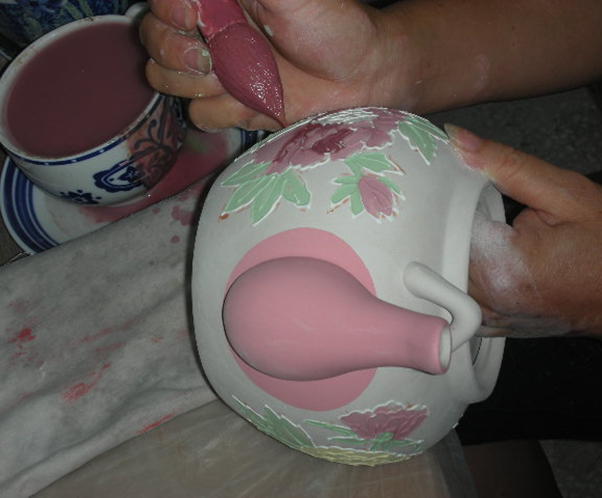
5. Hand printing on glaze
Product overglaze coloring operation, the product is painted on the glaze after the base color glaze is applied, which is called overglaze coloring or on-glaze manual printing.
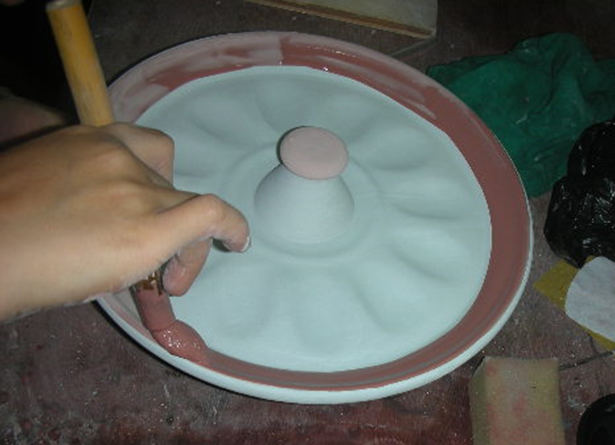
6. Decal paper (over-glaze decal/mid-glaze decal/under-glaze decal)
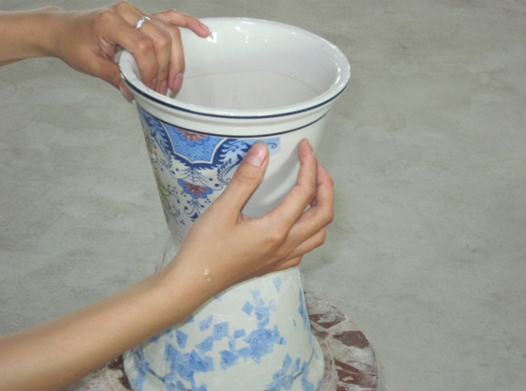
7.Electroplating
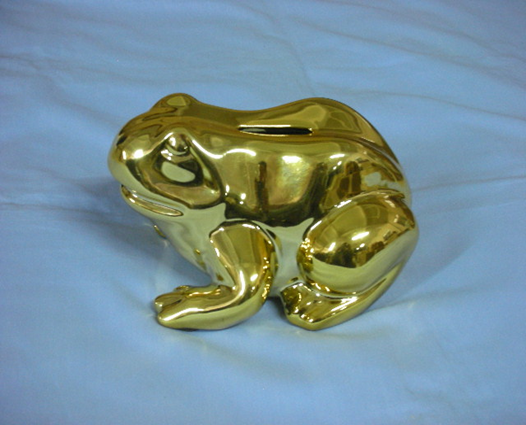
8. Alien
9. Thin
10. Machine printing
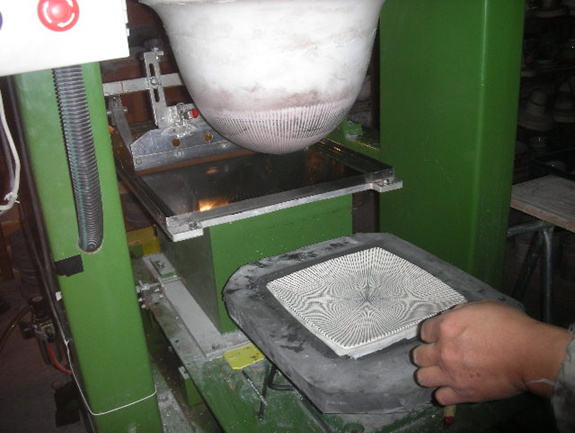
11. Appearance
12. Ceramic stacking

5. Ceramic glazing operation
The most commonly used methods for ceramic glazing include the following three operations:
1. Ceramic inner glaze operation
The inner glaze method on ceramics is mainly used for both internal and external colored glazes. The mouth of the product needs to be isolated with edges. The crack isolation effect has brown edges and white edges. Waxing water is generally used to isolate colored glaze products.
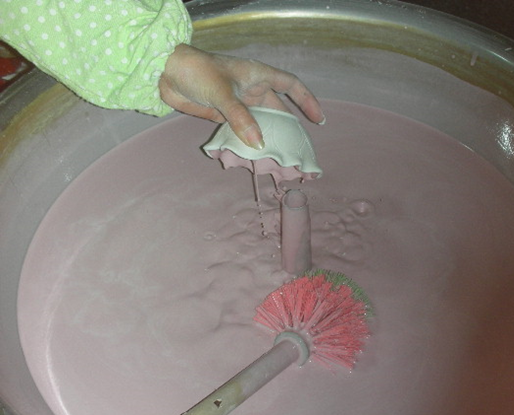
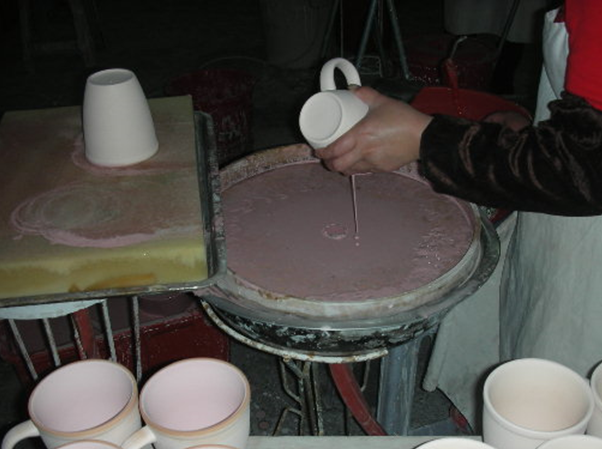
2. Ceramic outer glaze operation
The external glaze method on ceramics is mainly used for internal and external double-color glazes. The mouth of the product must be edge-isolated. The crack isolation effect has brown edges and white edges. Wax water is generally used to isolate colored glaze products.
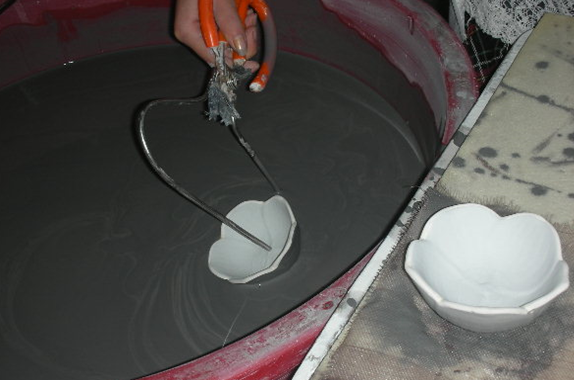
3. The entire ceramic glazing operation
The whole glazing method of ceramics is used for overglaze color, underglaze color, machine printing and other products. It is one of the most widely used glazing methods for products.
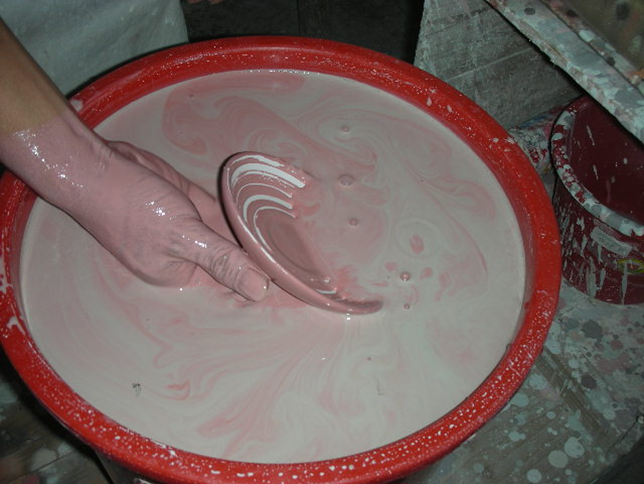
7. Main production defects of ceramics
1.Deformation
Product deformation generally refers to the appearance that the mouth of the product is not round, the edges and feet are uneven, the edges are not straight, the bottom is stepped on, and the product is crooked, etc.
Reasons for product deformation:
1. The product shape design is structurally unreasonable or does not meet the requirements of process materials and process technology.
Improper handling of the center of gravity position. The center of gravity of some products is biased to one side due to the shape of the cup. For example, due to the gravity of the cup handle, the upper mouth of the cup is deformed into an oval shape along the direction of the cup handle.
The product is too tall, too long, and the thickness and size of each part are inappropriate and uneven, etc. When some large products are fired, the bottom surface shrinks less than the top surface due to friction and is deformed.
2. Improper formulation of the mud material causes uneven shrinkage during firing. The amount of high plasticity clay in the mud material is too large, causing excessive shrinkage during drying and firing.
3. The expansion coefficients of mud and glaze are not matched properly.
4. The mud preparation process is not strict
The mud contains air or impurities, the mixing, stirring, and refining are insufficient, and the aging time is short.
If the moisture content of the mud material is too high or uneven, and the drying shrinkage is also large, the tendency of deformation will also be large.
5. Improper forming process
Forming pressure is too small or too large.
The forming equipment is poor and vibrates heavily.
The design of the rolling head is unreasonable, the inclination angle is too large or too small; the rolling head speed is improper and the installation is not good.
The mud is thrown incorrectly during rolling.
The blank plate, blank supporting plate and blank supporting frame are uneven.
6. Improper drying treatment
? Improper temperature control during drying and too fast drying speed.
? If all parts of the green body are unevenly dried, the moisture will spread unevenly, resulting in internal stress and deformation.
?The bad body is placed unevenly or placed improperly.
7. Improper embryo and kiln installation techniques
?The moisture content of the embryo body entering the kiln is too high.
?The silicon plate is uneven and the silicon columns are not straight, straight and unstable. During firing, the embryo body tilts to one side due to uneven shrinkage.
8. Improper firing process
?The temperature in the kiln is too high.
? The temperature rises too quickly during firing, the firing temperature is too high, and the high-fire heat preservation time is too long.
9. Poor quality of plaster molds
? The structure of the plaster mold is unreasonable, the molding does not meet the requirements, the specifications are not uniform, and the density is inconsistent.
? The moisture content of the plaster mold is uneven, too dry, too wet, too old, and the mold is deformed or worn.
?The fit between the plaster mold and the mold base is poor and inconsistent.
Symptoms and causes of some of the most common product deformations;
1. Edge sagging: refers to the collapse or eversion of the edge of the product, with part or all of the edge sagging.
? The product design is unreasonable. The thickness of the belly of the product is not enough, the bottom diameter is too small, the structure of the turning point of the edge is unreasonable, and the edge stretches too far around, etc.
?The mouth of the green body is too thin.
? If the green body is too wet, demoulding is carried out. The demoulding operation is performed with too much force and the movement is too violent, causing the mouth edge of the green body to evert out.
5. Concave-convex bottom: refers to a small arc-shaped depression or bulge in the center of the bottom of the product.
The refractory degree of mud material is low and the firing temperature is high.
The moisture content of the mud is too high or too low, and the moisture distribution is uneven.
The design of the rolling head is unreasonable, the inclination angle of the rolling head is too large or too small, the distance between the top of the rolling head and the embryo body is too small or too large, and the rotation speed of the rolling head is low or high.
The rolling head is installed incorrectly.
The mold is too wet and the water absorption rate is weakened.
The shape and structure of the product is unreasonable, the proportion of the mouth and the bottom is inappropriate, the bottom diameter is too large and exceeds its own load and sinks to the bottom.
2. Shrinking: refers to the product mouth shrinking too much inward. Mainly caused by improper demoulding and plastic surgery.
3. Triangular shape: refers to the triangular deformation of the edge of the product. Frequent demoulding processes occur, such as uneven drying and wetness of the mold or uneven temperature during drying of the mold, strong demoulding, etc.
4. Collapse: It means that the whole product collapses down and becomes shorter or collapses to one side.
Improper demoulding operation, the green body is demoulded when it is too wet, the demoulding operation is performed with too much force and the action is too violent, causing the green body to collapse to one side.
The embryo collapsed and became shorter due to falling.
The firing temperature is too high or the high fire holding time is too long, causing the product to collapse and deform.
6. Mouth, ears, and handle
The position, size, weight, extension angle, etc. of the mouth, ears, and handles are unreasonable in design.
Forcibly demoulding, using too much force, the pallet stored after demoulding is uneven, causing the mouth, ears, and handle accessories to deform.
The moisture content of the main and accessories is inconsistent and the gap is large.
The fineness, moisture, additives, etc. of the bonding mud formula are not well controlled.
The bonding method and technique are not well mastered. When bonding, the attachment and the main body are not aligned in the correct position, and the force is uneven or excessive, causing skew and deformation of the attachment after bonding.
Uneven drying, excessive firing temperature, etc. may cause the mouth, ears, and handle to become skewed due to deformation.
7. Inappropriate cover and body: It means that the cover of the product does not match the body.
The shape or size of the cover and body is improperly designed.
During firing, glaze, pimples or adhesions may accumulate on the surface of the lid or body, causing the lid or body to not fit properly.
?When the cover and body are fired separately, the firing temperature is significantly different, causing changes in shape and size. If the lid and body don't match when they are being burned, it means the lid and body are mismatched.
The shape or repair of the blank is not done according to the standards, so that the shape of the body and cover does not meet the standards. For example, the mouth of a pot or cup is opened wider or smaller.
The cover body does not fit due to deformation of the product itself.
Solution: To overcome the deformation defects of ceramic products, the formula should be considered to reduce the shrinkage of the product, make all parts of the blank as uniform as possible, reasonably design the shape of the device, improve the molding method, etc. in addition. Management of each process must be strengthened to overcome man-made deformations.
2.Color difference
It refers to the differences shown by different individuals when the same color product is mass produced.
Causes of color difference:
1. The fineness and thickness of the glaze particles affect the uniformity, suspension and stability of the glaze water. If the glaze particles are too coarse, it will easily lead to layered precipitation of the glaze, making it difficult to control its uniformity during operation, causing changes in the concentration of glaze adsorbed by successively glazed bodies and the thickness of the glaze layer.
2. Caused by the glazing process operation. When the same product is glazed, due to the inconsistent or large difference in the length of the glaze dipping in some parts, the thickness of the glaze layer in each part of the product is inconsistent, resulting in color difference of a single product.
3. The dryness and humidity between the green bodies or individual parts of the green body are inconsistent. Even if the glaze soaking time is the same during glazing, the thickness of the glaze layer in each part will be inconsistent, resulting in color differences between products or between the same product.
4. The color difference caused by the shape of the product, such as the cup handle, spout, handle, plate edge and lid, etc., cannot absorb glaze of the same thickness due to the relatively straight edges; or the forming process between the parts is inconsistent. The density of the green body is different, and the color difference caused by the inconsistent glaze layer when absorbing glaze water during glaze soaking.
5. The influence of firing temperature on product color difference. Each color glaze has a corresponding firing temperature. If the firing temperature is inconsistent between the same color, it will inevitably affect the color of the product.
6. The color difference of refired products. The color of the product after repairing and reburning due to other quality problems will form a color difference from the one-time fired product.
7. Problems with raw material formulas. Color differences may occur in different batches of raw materials for the same batch of products during production.
Solution:
1. Strictly control the glaze grinding process.
2. Control the concentration of glaze water during glazing, and stir and measure frequently during the glazing process.
3. When glazing, the workers? movements should be standardized and even. The residence time of the green body in the glaze water should be as consistent as possible, and the thickness of the glaze layer of the combined body should be close to the same. However, it is also necessary to avoid cracking and peeling of the green body due to too long glazing time. Bubble, glaze shrinkage, etc.
4. Control the dryness and humidity of the green body.
5. Products with special shapes or joints must control the glazing operation, such as increasing the glazing time of the joints.
6. When firing, control the pouring temperature and when loading the kiln, load the kiln according to the distribution of the kiln temperature. Try to load the kiln according to the appropriate temperature of the color.
7. During the production process, each process should increase the yield of the product, try to slow down and reduce the proportion of back-burning. When back-burning, it is also necessary to select the appropriate burning layer according to the color characteristics of the product.
8. Strengthen the debugging of color materials and glaze water before production in the factory.
3. Dirty color
Color stain refers to the appearance of undesirable staining on the surface of the product.
cause:
1. If the products are stacked after painting, there will be traces of adhesion on the flower surface because the paint is not dry.
2. After painting, the products are too close to each other and touch each other. The paint is not dry, causing traces of adhesion on the flower surface.
3. The painter has paint stuck on his hand to pick up the product.
4. Debris or impurities fall on the surface during painting.
5. The glazing workers? operating techniques were irregular and they held the glazing surface with their hands. Because the paint was not dry, the color spread in the direction of the fingerprints.
6. The glaze installer's operation is not standardized. When installing the kiln, he directly touches the flower surface with his hands or has colorants from other products stuck to his hands.
7. The glaze water contains impurities, and when fired at high temperatures, it will produce color stains manifested by chemical reactions.
8. When the baked flower product is installed in the baked flower kiln, the surface or edges of the product are in direct contact with the iron frame or chain of the baked flower kiln, causing the surface to become dirty.
9. For decal products, paper shreds are pasted on the blank space of the product.
Solution:
1. Painted products should be carefully painted, glazed, and installed in the kiln, and try not to come into contact with the painted surface.
2. Pay attention to the workers' techniques and clean hands during each process.
3. Prevent color chips and impurities from falling on the surface of the product during painting.
4. Protect the hygiene of the glaze water and prevent other impurities from falling into the glaze water.
5. When baking flowers and installing them in the kiln, control the corners of the product surface so that they do not come into direct contact with the iron products of the kiln.
6. If the product is stained in a small area, it can be polished and filled with glaze water before being refired.
7. If the burnt pattern is dirty, you can use dilute sulfuric acid to lightly wash the stained part.
8. When decaling products, control the decorative paper shreds and place them appropriately on the excess parts of the product.
4. Missing glaze
Glaze shrinkage: Local unglazed defects will appear on the surface of glazed products after firing.
1. The dust and oil stains on the surface of the body were not cleaned before glazing.
2. The glaze layer is too thick and will fall off after drying.
3. The glaze particles are too fine.
4. The glazed body may be bumped or rubbed off during processing and transportation.
5. The viscosity of the glaze is too small or the glazing operation is improper.
6. There is too much moisture in the kiln during firing, and the body is wet, causing the glaze to be stratified in the middle.
7. The body has joints or the surface of the body is uneven (such as negative carving, relief carving), resulting in uneven glaze and glaze accumulation. If the glaze water accumulates too much, glaze shrinkage will occur during firing.
8. Excessive accumulation of color in painted products, inappropriate color formula, glazing immediately after painting, etc. will affect the water absorption of the flower surface and reduce the glaze water, resulting in glaze shrinkage.
9. The environmental humidity of the large body and the colorants will also cause glaze shrinkage.
10. The temperature control during kiln firing is not in place.
Solution:
1. Dust and oil stains on the body should be removed before glazing.
2. Adjust the proportion of glaze to meet the process standards.
3. Adjust the glaze formula to suit the base glaze.
4. Control the fineness of the glaze and the thickness of the glaze.
5. The glazed body must be handled carefully when processing and handling, handle it with care, and keep it stable.
6. Control the operation when glazing according to different shapes. For example, before glazing joints and relief products, use a sponge or brush to moisten the parts that are prone to glaze accumulation with clean water to reduce the thickness of the glaze water absorbed by this part. .
7. Control the appropriate firing temperature of glaze water.
8. Glaze shrinkage products can be re-glazed and refired.
5. Pinhole
It refers to the pinhole-sized holes on the surface of the product after it is fired.
Causes of pinholes:
1. There are too many impurities in the mud and glaze. When fired at high temperatures, chemical reactions will produce gases, causing pinholes and bubbles on the glaze surface. For example, the raw materials contain too much organic matter and carbon, iron sulfide, carbonate, sulfate and high-priced iron.
2. If the grouting model is too dry and absorbs water quickly, it is also easy to cause pinholes in the glaze; if the model is too wet and absorbs water too slowly, it is also easy to cause pinholes in the glaze.
3. The green body is too dry and overheated before glazing, and the surface of the green body is not completely moistened during washing, so that the glaze cannot be evenly absorbed by the green body, and it is easy to seal the gas and cause pinholes or bubbles in the glaze.
4.? If the green body is glazed if it is too wet, and if it is fired before drying after glazing, pinholes and bubbles will occur due to the large amount of water vapor escaping during firing.
5. The green body was not washed properly and no attention was paid to the washing water. Organic dust stuck to the green body, which also turned into glaze pinholes during firing.
6.? If the glaze slurry is too thin or too thick, it will not only easily cause glaze cracks, but also easily cause pinholes or bubbles in the glaze because it is easy to seal the gas.
7.? If the grouting product is grouted too quickly and the air cannot be fully discharged, or if the mud is overheated and easily becomes acidic and loses moisture, and the bubbles are not easily discharged, glaze pinholes or bubbles are prone to appear.
8,. When the wet blank is dried using the waste heat of the kiln, if the time is too long, the blank will absorb a large amount of carbon and easily form glaze pinholes or bubbles; or the glaze blank will be left for too long, and a large amount of organic impurities will stick to the blank. Dust, and the organic impurities and dust are not blown away when loading the blank, which may also produce glaze pinholes or bubbles.
9. The thickness of the glaze layer is too thin, and part of the glaze is absorbed by the porous body to form glaze pinholes.
10. The model design is unreasonable, and the gas cannot be discharged during grouting. The gas enclosed in the body can easily form glaze pinholes or bubbles during firing; the dust on the model cannot be completely eliminated, and the floating dust volatilizes during firing, causing the product to produce Glazed pinholes.
11. Improper glazing process can also easily produce pinholes or bubbles in the glaze. There is dust on the green body and it is not cleaned before glazing. Pinholes or bubbles will appear in the glaze during the firing process.
12? Uneven drying of the green body can easily produce pinholes or bubbles in the glaze.
13. The color material on the surface of the painted product body is too thick, or the water is not dry before being glazed after the color is painted. When the kiln is fired, the water in the body and the color material cannot be discharged, forming pinholes and bubbling.
Solution:
1. Reduce impurities in raw materials.
2. Use high-quality plaster to make impressions.
3. Control the concentration of mud.
4. Control the requirements of each process of the forming process.
5. Control the cleanliness of the green body.
6. Control the stability and operating specifications of the glaze water.
7. Control the kiln firing temperature.
8. Control the drying uniformity of the green body.
9. Pinhole products can be reglazed and refired.
10. Painted products or large-area colored products need to be fired before being glazed.
9. Ceramic quality inspection
Ceramic quality inspection must be strict so that product packaging quality can be guaranteed.
Authentic product: The product is consistent with the shipping confirmation sample and has no obvious defects. There is not a slight pinhole in the main part of the product. The color difference of the product is slight and it can be authentic. Grind the selected ceramics to the bottom, note the quantity and send it to the packaging warehouse.
Defective product: The product has major defects, serious color difference, severe deformation, cracking, severe glaze shrinkage, slag falling, pinholes, blistering, and must be scrapped.
评论
发表评论